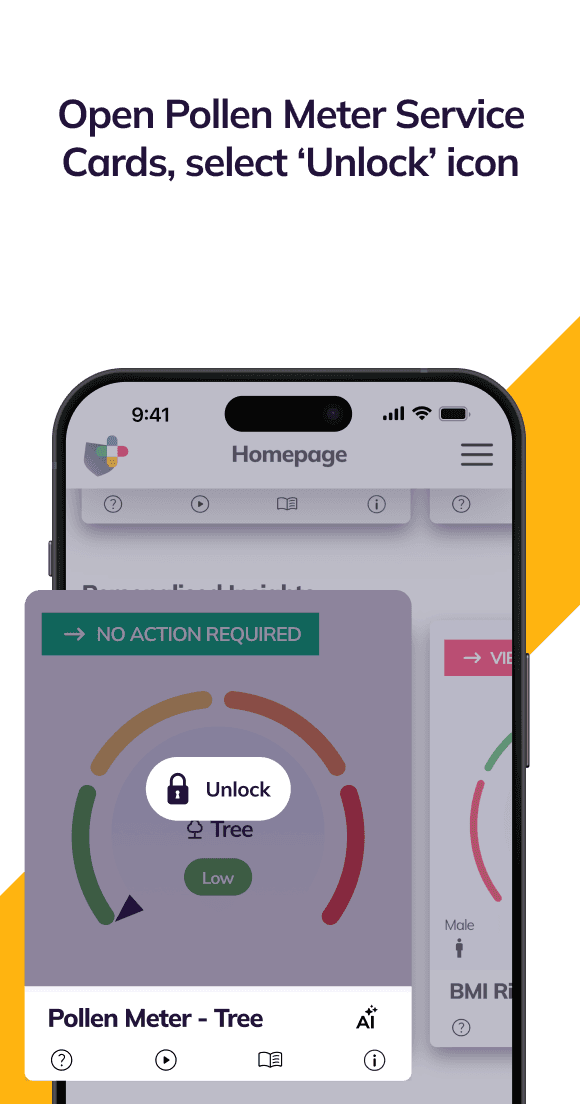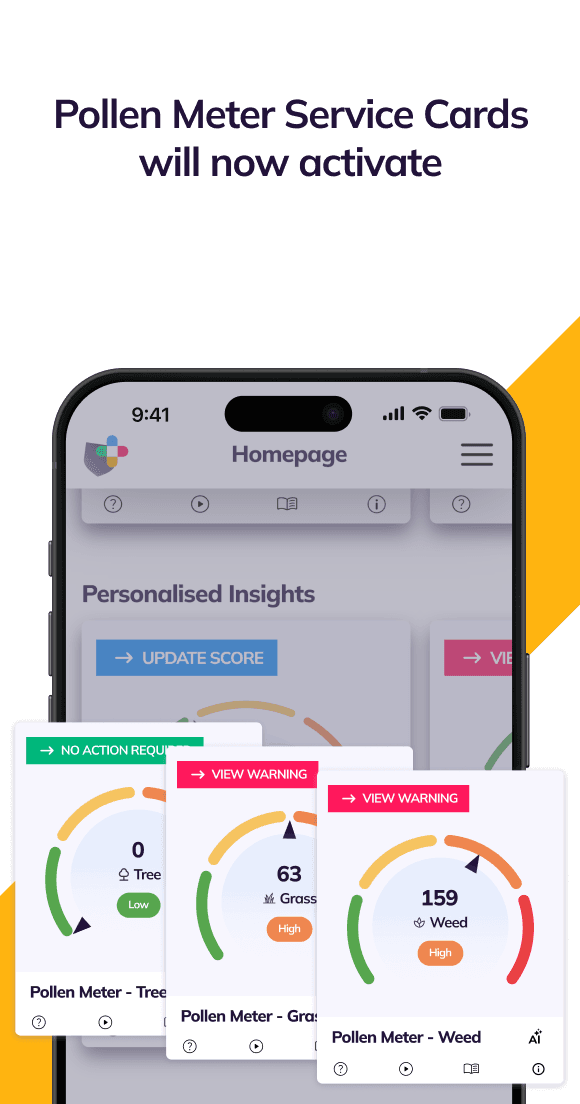How Pollen Meter Works
Stay ahead of pollen allergies with the FREE Pollen Meter Service. Track tree, grass, and weed pollen levels in your area using real-time data measured in Pollen Grains Per Cubic Metre (PPM).
If you have asthma, COPD, allergies, hay fever, or chronic bronchitis, high pollen counts can trigger wheezing, breathlessness, and chest tightness. Our AI algorithms combine local pollen readings with your health profile to deliver personalized clinical warnings.
Smooth, simple, seamless
Your Guide to Using the Pollen Meter App Feature
Service Guide
Everything You Need to Know About the Pollen Meter
What is the Pollen Meter Service and how does it work?
The Pollen Meter Service is a visual indicator that tracks three different pollen types in your area.
It uses a metric called Pollen Grains Per Cubic Metre (PPM) to show how much pollen type (Tree, Grass, Weed) is in the air. The larger the number, the worse the pollen type. The risk levels are denoted as Low, Moderate, High, or Very High. These risk levels are also sensitive to your underlying health condition(s).
How can I view the Pollen count in my area?
You can view the live Weed, Grass and Tree Pollen counts in your area by navigating to the ‘Personalised Insights’ section of the account homepage. Here you will see three service cards covering the three different types of pollen (Tree, Grass, Weed).
Do I need to update my health profile to make full use of the Pollen Meter Service?
To make best use of the service, you will need to update the health profile with your health conditions. If you are accessing the Pollen Meter for the first time, the Service Cards will need to be activated. You can activate them by clicking the ‘Unlock’ icon. This will send you to the health profile page, where you can update your health conditions. Click Save. You will now be set up for personalised warning notifications.
The Pollen Meter will now send you personalised clinical warnings based on the combination of the pollen readings in your area and your health condition(s).
Do I need to have location services on my device activated?
When you activate the Service Cards for the first time, you will be prompted to allow our service to access your current location. Please ensure you enable this.
How often are the Pollen readings updated?
The Pollen readings are refreshed each day.
What happens after I activate the Pollen Meter Service?
Once you have updated the health profile and enabled location services on your device, the Pollen Meter will now monitor the pollen levels in your area and send you personalised clinical warnings based on the combination of the pollen readings in your area and your health condition(s).
How will I be able to receive personalised Pollen Meter warnings?
Each Pollen Meter Service Card (Tree, Weed, Grass) will show you a reading and an associated risk, if applicable.
Our AI algorithms trigger warnings based on a combination of local pollen counts and your personal health condition(s). If our algorithm identifies a risk, you will receive a push notification with clinical advice on what to do next, which will be sent to your device, as well as an In-App notification which can be viewed in your ‘Notifications’ Section of the account homepage.
You can also view the warning advisory by clicking the ‘View Warning’ button on the Service Card.
How can the Pollen Meter benefit my health?
Allergies to tree, grass, or weed pollen cause hay fever, which can affect lung conditions like asthma and COPD (chronic obstructive pulmonary disease).
The NowPatient Pollen Meter sends you medically approved conditional warnings based on the pollen count in your location and your pre-existing medical conditions, if you have any.
For example, if you are in an at-risk group like an Asthmatic or suffer from COPD, and the grass pollen count in your location is 61-341, then we will send you an advisory HIGH RISK notification describing what precautions you need to take to prevent the exacerbation of your condition.
What are at-risk groups?
At-risk groups are defined as adults and children with heart or lung problems, who are at greater risk of symptoms. Follow your doctor’s usual advice about exercising and managing your condition.
It is possible that very sensitive individuals may experience health effects, even on low pollen count days. Anyone experiencing severe symptoms should seek medical advice.
What conditions are monitored as part of the warning notifications?
The following conditions are classed as ‘at risk’ for sensitivity to Pollen Counts:
- Allergies
- Asthma
- Chronic Bronchitis
- Chronic Obstructive Pulmonary Disease (COPD)
- Hay Fever
Do I need to pay for using the Pollen Meter?
No. The Pollen Meter is a free service available for registered users of NowPatient.
When should I see a doctor?
If the pollen count is Moderate, High, or Very High and you are Asthmatic, have Allergies, COPD, or Bronchitis; you should make an appointment with your doctor if you observe the following worsening symptoms:
- Feel wheezy
- Feel breathless
- Have a tight feeling in your chest
- Are coughing more than usual
- Have asthma and need to use your reliever inhaler (usually blue) three times a week or more
What are the different types of pollen?
There are different types of pollen. You can be allergic to more than one kind of pollen across the year.
- Tree pollen is a common hay fever trigger. It’s the first type of pollen released every year. Levels are usually highest from late March to mid-May. The most common tree pollen allergy is birch tree pollen, which affects about 20% of people with hay fever
- Grass pollen is the most common hay fever trigger and affects about 95% of people who have hay fever. Grass pollen is often highest between mid-May and July. There’s evidence that when grass pollen levels are high, there is an increase in the number of people with asthma needing hospital treatment for their symptoms. There is also some evidence that suggests a link between high levels of grass pollen and increased numbers of COPD hospital admissions
- Hay fever can also be triggered by weed pollen, which is usually highest from the end of June until September
Can I rely on the data you are using?
Yes. Our service is NAB certified and compliant. NAB is the National Allergy Bureau.
What do the results mean?
The table below outlines the scores to determine the risk level of each pollen type.
Is the Pollen Meter safe for me to use?
Yes. The Pollen Meter is classified as a class I medical device under UK MDR 2002 regulations, for its intended use.








